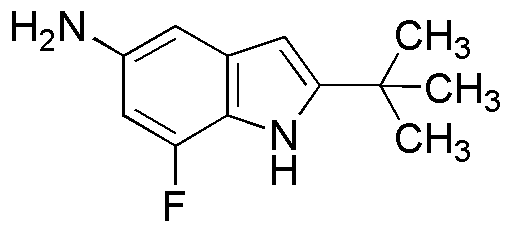2-(tert-Butyl)-7-fluoro-1H-indol-5-amine is widely utilized in research focused on:
- Pharmaceutical Development: This compound serves as a key intermediate in the synthesis of various pharmaceuticals, particularly in the development of drugs targeting neurological disorders.
- Biological Research: It is used in studies investigating receptor interactions and signaling pathways, providing insights into cellular processes and potential therapeutic targets.
- Material Science: The compound is explored for its properties in developing advanced materials, including polymers and coatings that require specific chemical stability and reactivity.
- Fluorescent Probes: Its unique fluorine substitution makes it suitable for creating fluorescent probes used in imaging techniques, enhancing the visibility of biological samples.
- Organic Synthesis: This chemical is a valuable building block in organic synthesis, allowing chemists to create complex molecules efficiently, which is crucial in various industrial applications.
General Information
Properties
Safety and Regulations
Applications
2-(tert-Butyl)-7-fluoro-1H-indol-5-amine is widely utilized in research focused on:
- Pharmaceutical Development: This compound serves as a key intermediate in the synthesis of various pharmaceuticals, particularly in the development of drugs targeting neurological disorders.
- Biological Research: It is used in studies investigating receptor interactions and signaling pathways, providing insights into cellular processes and potential therapeutic targets.
- Material Science: The compound is explored for its properties in developing advanced materials, including polymers and coatings that require specific chemical stability and reactivity.
- Fluorescent Probes: Its unique fluorine substitution makes it suitable for creating fluorescent probes used in imaging techniques, enhancing the visibility of biological samples.
- Organic Synthesis: This chemical is a valuable building block in organic synthesis, allowing chemists to create complex molecules efficiently, which is crucial in various industrial applications.
Documents
Safety Data Sheets (SDS)
The SDS provides comprehensive safety information on handling, storage, and disposal of the product.
Product Specification (PS)
The PS provides a comprehensive breakdown of the product’s properties, including chemical composition, physical state, purity, and storage requirements. It also details acceptable quality ranges and the product's intended applications.
Certificates of Analysis (COA)
Search for Certificates of Analysis (COA) by entering the products Lot Number. Lot and Batch Numbers can be found on a product’s label following the words ‘Lot’ or ‘Batch’.
Numéro de catalogue
Numéro de lot/série
Certificates Of Origin (COO)
This COO confirms the country where the product was manufactured, and also details the materials and components used in it and whether it is derived from natural, synthetic, or other specific sources. This certificate may be required for customs, trade, and regulatory compliance.
Numéro de catalogue
Numéro de lot/série
Safety Data Sheets (SDS)
The SDS provides comprehensive safety information on handling, storage, and disposal of the product.
DownloadProduct Specification (PS)
The PS provides a comprehensive breakdown of the product’s properties, including chemical composition, physical state, purity, and storage requirements. It also details acceptable quality ranges and the product's intended applications.
DownloadCertificates of Analysis (COA)
Search for Certificates of Analysis (COA) by entering the products Lot Number. Lot and Batch Numbers can be found on a product’s label following the words ‘Lot’ or ‘Batch’.
Numéro de catalogue
Numéro de lot/série
Certificates Of Origin (COO)
This COO confirms the country where the product was manufactured, and also details the materials and components used in it and whether it is derived from natural, synthetic, or other specific sources. This certificate may be required for customs, trade, and regulatory compliance.


